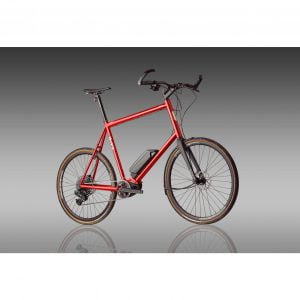 If your bike has a scary high-speed shimmy, what can you do?
If your bike has a scary high-speed shimmy, what can you do?
Wheel stiffness has a lot to do with it, as does frame torsional stiffness and the amount of vibration absorption in the fork. In general, it is only an issue for tall bikes and tall riders, with its severity increasing with rider weight.
So, how can you stop death wobble? One thing you can do right off is try some stiffer wheels. You can also check that the hub bearings and headset bearings are not out of adjustment. If the headset is too tight and thus can’t adjust quickly enough to inputs, or if the hubs or headset are loose and rattling about, shimmy can also result. Obviously, make sure your hub quick-release skewers are tight, too.
What Causes Front-End Shimmy?
Until a few years ago, I had thought that bicycle shimmy was a resonance phenomenon, but now I believe that it is actually a Hopf bifurcation. You may know of the Tacoma Narrows Bridge Collapse, which I remember as a physics student being explained as a function of the wind somehow exciting the resonant frequency of the bridge. I believe that now there is relatively universal agreement that it was a Hopf bifurcation that brought it down.
That said, relating to both the bridge collapse and death wobble as resonance phenomena can still teach us how to stop problems from occurring. My efforts to increase the resonant frequency of the bicycle/rider combination always reduced shimmy. The taller the bike and the heavier the rider, the longer it takes to twist back and forth through one cycle. So to shorten the period of oscillation, you can make the frame stiffer, tighter, and smaller, and you can reduce the weight of the rider and of any other weight on the bike.
Shimmy is a function not just of speed and rider weight and weight positioning, but also of environmental factors like wind and road surface. My guess first of all is that on a different day without wind, you could ride the same section of road at the same speed and not have it happen.
Frame Design

My frame design for big bikes and riders has a number of features designed to increase the frame torsional stiffness as well as the amount of vibration absorption in the fork. I was the first to use 1-1/8” (rather than 1”) fork steering tubes on road bikes (in the early 1990s) as a way to stiffen the front end of the bike as well as the steering tube itself; now we use even bigger head tubes and a tapered fork steerer that’s even bigger at its base. By lowering and sloping the top tube, as well as increasing the diameters of the tubes, front-end shimmy is reduced. This is a crucial part in stopping death wobble from happening.
These things all increase the torsional stiffness of the frame, as does shortening the seat tube from the bottom, too, by raising the bottom bracket to adjust for the long cranks (which maintain a standard proportionality to rider leg length). And there is a consequent shortening of the down tube, top tube, seat stays, and chain stays simply by changing the angles of those tubes. And using a shallower head angle makes the fork angle out ahead more, which both increases the stability of the bike as well as allows the fork to absorb more road shock along the fork legs.
With all that said, frames can lose stiffness over time, and it is always possible to make a stiffer frame, if a given one isn’t stiff enough for someone. Reach out to us at Zinn Cycles for a custom bike and stop death wobble from ever occurring again.


